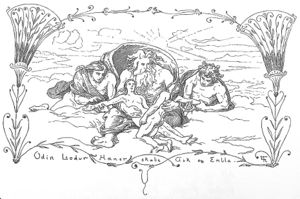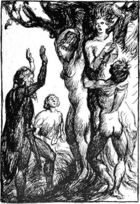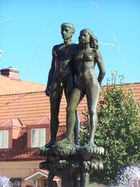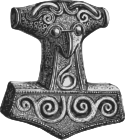Ask and Embla

In Norse mythology, Ask and Embla (Old Norse: Askr ok Embla)—male and female respectively—were the first two humans created by the gods. The pair are attested in both the Poetic Edda, compiled in the 13th century from earlier traditional sources, and the Prose Edda, written in the 13th century by Snorri Sturluson. In both sources, three gods, one of which is Odin, find Ask and Embla and bestow upon them various corporeal and spiritual gifts. A number of theories seeking to explain the two figures have been proposed, and there are occasional references to them in popular culture.
Contents |
Etymology

Old Norse askr literally means "ash tree" but the etymology of embla is uncertain, and two possibilities of the meaning of embla are generally proposed. The first meaning, "elm tree", is problematic, and is reached by deriving *Elm-la from *Almilōn and subsequently to almr ("elm").[1] The second suggestion is "vine", which is reached through *Ambilō, which may be related to the Greek term ámpelos, itself meaning "vine, liana".[1] The latter etymology has resulted in a number of theories.
According to Benjamin Thorpe "Grimm says the word embla, emla, signifies a busy woman, from amr, ambr, aml, ambl, assiduous labour; the same relation as Meshia and Meshiane, the ancient Persian names of the first man and woman, who were also formed from trees."[2]
Attestations
In stanza 17 of the Poetic Edda poem Völuspá, the völva reciting the poem describes that Hœnir, Lóðurr and Odin once found Ask and Embla on land. The völva says that the two were capable of very little, lacking in ørlög and describes that they were given three gifts by the three gods:
- Old Norse:
- Ǫnd þau né átto, óð þau né hǫfðo,
- lá né læti né lito góða.
- Ǫnd gaf Óðinn, óð gaf Hœnir,
- lá gaf Lóðurr ok lito góða.[3]
- Benjamin Thorpe translation:
- Spirit they possessed not, sense they had not,
- blood nor motive powers, nor goodly colour.
- Spirit gave Odin, sense gave Hœnir,
- blood gave Lodur, and goodly colour.[4]
- Henry Adams Bellows translation:
- Soul they had not, sense they had not,
- Heat nor motion, nor goodly hue;
- Soul gave Othin, sense gave Hönir,
- Heat gave Lothur and goodly hue.[5]
According to chapter 9 of the Prose Edda book Gylfaginning, the three brothers Vili, Vé, and Odin, are the creators of the first man and woman. The brothers were once walking along a beach and found two trees there. They took the wood and from it created the first human beings; Ask and Embla. One of the three gave them the breath of life, the second gave them movement and intelligence, and the third gave them shape, speech, hearing and sight. Further, the three gods gave them clothing and names. Ask and Embla go on to become the progenitors of all humanity and were given a home within the walls of Midgard.[6]
Theories

A Proto-Indo-European basis has been theorized for the duo based on the etymology of embla meaning "vine." In Indo-European societies, an analogy is derived from the drilling of fire and sexual intercourse. Vines were used as a flammable wood, where they were placed beneath a drill made of harder wood, resulting in fire. Further evidence of ritual making of fire in Scandinavia has been theorized from a depiction on a stone plate on a Bronze Age grave in Kivik, Scania, Sweden.[1]
A figure named Æsc (Old English "ash tree") appears as the son of Hengest in the Anglo-Saxon genealogy for the kings of Kent. This has resulted in an amount of theories that the figures may have had an earlier basis in pre-Norse Germanic mythology.[7]
Connections have been proposed between Ask and Embla and the Vandal kings Assi and Ambri, attested in Paul the Deacon's 7th century AD work Origo Gentis Langobardorum. There, the two ask the god Godan (Odin) for victory. The name Ambri, like Embla, likely derives from *Ambilō.[1]
A preceding stanza to the account of the creation of Ask and Embla in Völuspá provides a catalog of dwarves, and stanza 10 has been considered as describing the creation of human forms from the earth. This may potentially mean that dwarves formed humans, and that the three gods gave them life.[8] Carolyne Larrington theorizes that humans are metaphorically designated as trees in Old Norse works (examples include "trees of jewellery" for women and "trees of battle" for men) due to the origin of humankind stemming from trees; Ask and Embla.[9]
Modern influence
Ask and Embla have been the subject of a number of references and artistic depictions. A sculpture depicting the two stands in the southern Swedish city of Sölvesborg, created in 1948 by Stig Blomberg. Ask and Embla are depicted on two of the sixteen wooden panels found on the Oslo City Hall in Oslo, Norway by Dagfin Werenskjold.[10] In 2003, Faroese artist Anker Eli Petersen included a depiction of the couple in his series of Faroe Islands stamps.
See also
- Líf and Lífþrasir, two humans who survive the events of Ragnarök and repopulate the reborn world in Norse mythology.
Notes
- ↑ 1.0 1.1 1.2 1.3 Simek (2007:74).
- ↑ Thorpe (1907:337).
- ↑ Dronke (1997:11).
- ↑ Thorpe (1866:5).
- ↑ Bellows (1936:8).
- ↑ Byock (2006:18).
- ↑ Orchard (1997:8).
- ↑ Lindow (2001:62-63).
- ↑ Larrington (1999:279).
- ↑ Municipality of Oslo (2001-06-26). "Yggdrasilfrisen" (in Norwegian). http://www.oslo.kommune.no/losartikler/article23199-7726.html?articleID=23199&categoryID=7726&tip=1. Retrieved 2008-09-08.
References
- Bellows, Henry Adams (Trans.) (1936). The Poetic Edda. Princeton University Press. New York: The American-Scandinavian Foundation.
- Byock, Jesse (Trans.) (2006). The Prose Edda. Penguin Classics. ISBN 0140447555
- Dronke, Ursula (Trans.) (1997). The Poetic Edda: Volume II: Mythological Poems. Oxford University Press. ISBN 0198111819
- Larrington, Carolyne (Trans.) (1999). The Poetic Edda. Oxford World's Classics. ISBN 0192839462
- Lindow, John (2001). Norse Mythology: A Guide to the Gods, Heroes, Rituals, and Beliefs. Oxford University Press. ISBN 0-19-515382-0
- Orchard, Andy (1997). Dictionary of Norse Myth and Legend. Cassell. ISBN 0 304 34520 2
- Simek, Rudolf (2007) translated by Angela Hall. Dictionary of Northern Mythology. D.S. Brewer. ISBN 0859915131
- Thorpe, Benjamin (Trans.) (1907). The Elder Edda of Saemund Sigfusson. Norrœna Society.
- Thorpe, Benjamin (Trans.) (1866). Edda Sæmundar Hinns Frôða: The Edda of Sæmund the Learned. Part I. London: Trübner & Co.
|
|||||||||||||||||||||||||||||||||
